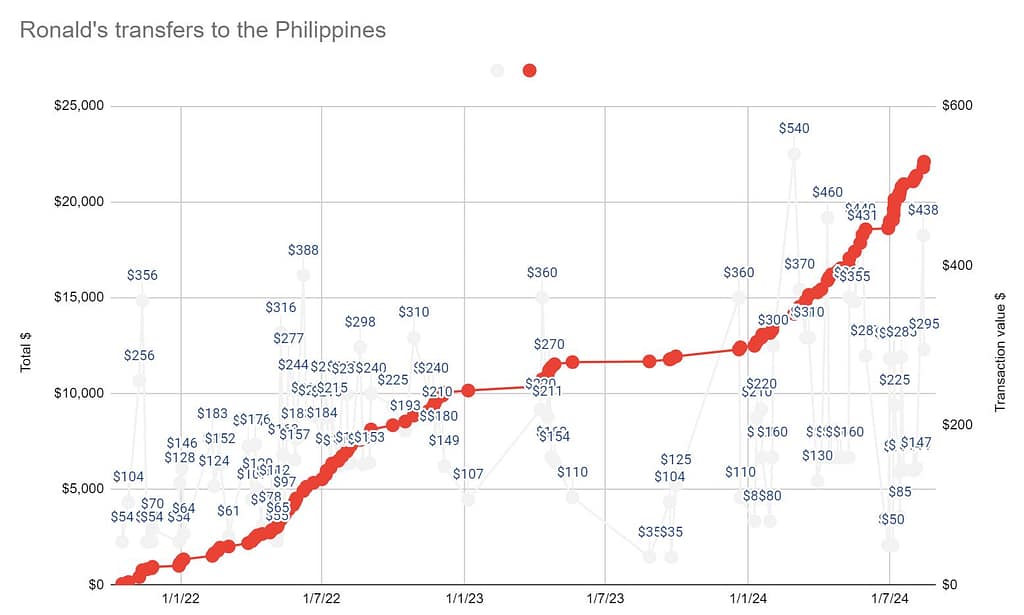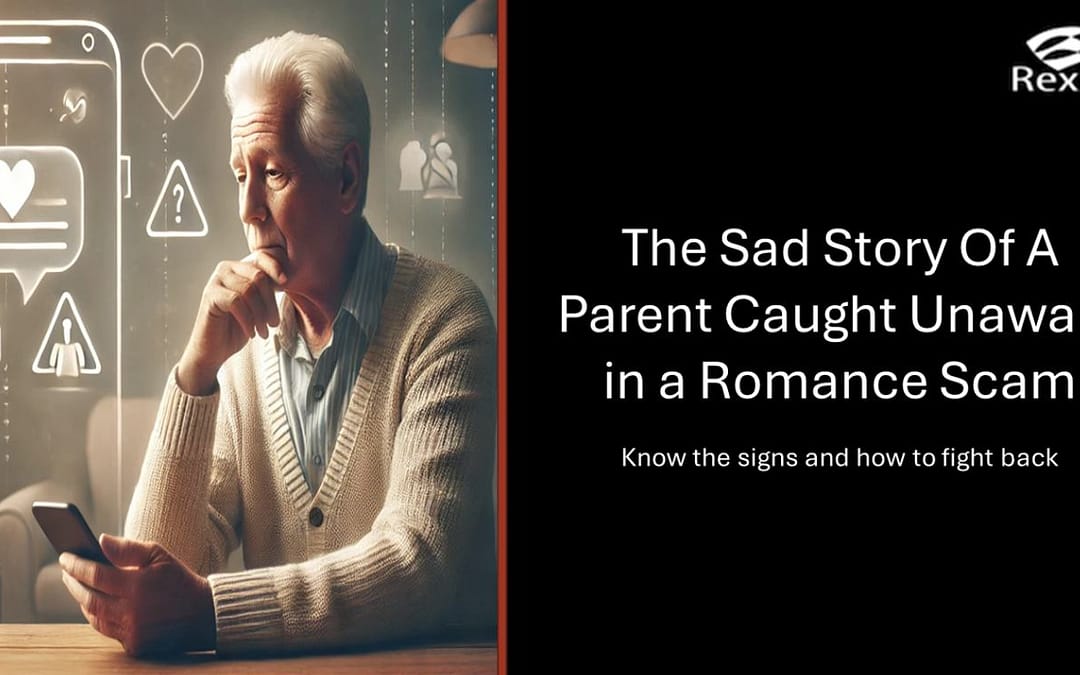How Elderly Romance Scams Unfold
In an increasingly digital world, the opportunities to connect with others have never been greater. Social media platforms, dating apps, and messaging services make it possible to form relationships with people across the globe. Unfortunately, this connectivity also opens the door to exploitation, particularly for vulnerable individuals. Elderly romance scams, a type of online fraud, have become a significant concern, especially for seniors seeking companionship. This blog post will explore the story of Ronald (not his real name), a 75+ Australian pensioner, who fell victim to an elderly romance scam that spanned over three years and cost him $22,900. By understanding Ronald’s experience, we can learn how to protect seniors from scams and keep our loved ones safe.
The Beginning: A Digital Connection
Ronald, a pensioner in his late 70s, lived a quiet life in Australia following the passing of his wife some 10 years earlier. Like many seniors, he faced loneliness and sought companionship in the digital world. It was in this space that he met Mary (not her real name), a woman from the Philippines who claimed to be raising three children on her own. Their initial connection seemed innocent enough—two people looking for someone to talk to, to share their lives with, and perhaps, to find love.
As their relationship developed over time, Ronald found himself increasingly drawn to Mary. They communicated frequently through WhatsApp, sharing messages, audio recordings, and even video calls. To Ronald, Mary seemed genuine. She spoke of her struggles, the challenges of raising three children in poverty, and the constant emergencies that seemed to plague her life. These conversations played on Ronald’s compassionate nature, making him feel responsible for her well-being.
A Relationship Built on Trust—and Deception
Over three years, Ronald’s relationship with Mary deepened. He began to trust her completely, despite the fact that they had never met in person. This trust became the foundation on which Mary built her requests for financial assistance. She never outright demanded money but instead portrayed herself as being in dire need. Each request was framed as an urgent necessity: a child needing medical care, school fees that needed to be paid, or food that had to be bought.
Mary was careful in how she asked for help. She didn’t request money on every call, and there were periods where she refrained from asking for anything at all. This strategy allowed her to maintain Ronald’s trust and avoid raising suspicion. However, the requests came frequently enough to add up over time. Ronald sent money to Mary through various channels—Western Union, MoneyGram, and Remitly—in small amounts ranging from $50 to $400 per transaction.

The story of Ronald and Mary is a classic example of how elderly romance scams are carefully orchestrated to build trust over time, making it difficult for the victim to recognize the deception. This is why it is so important to protect seniors from scams by being vigilant and aware of these tactics.
The Financial Impact: Small Transactions, Big Losses
While each individual transaction might have seemed insignificant to Ronald, the cumulative effect was staggering. Over 97 transactions, Ronald sent a total of $22,900 to Mary. To put this in perspective, this amount is roughly 1.4 times the average annual wage in the Philippines, yet there was no apparent improvement in Mary’s living conditions. She continued to portray herself as living in poverty, constantly facing new emergencies that required Ronald’s financial assistance.
The financial toll on Ronald was significant. Despite being a pensioner who worked part-time at a cleaning job to make ends meet, Ronald continued to send money to Mary. His own living conditions deteriorated as a result. His washing machine remained broken for over a year, his oven was unusable, and his car was held together with duct tape. Yet, when confronted by his family, Ronald defended his actions, saying, “But what if she’s genuine? Should I leave her without help?”
This scenario is all too common in elderly romance scams, where victims are manipulated into believing they are helping someone in genuine need. It underscores the necessity of taking steps to protect seniors from scams by monitoring their financial transactions and ensuring they understand the risks.
The Psychological Manipulation: How Scammers Exploit Emotions
Elderly romance scams are insidious because they exploit the emotions of their victims. In Ronald’s case, Mary crafted a narrative that played on his empathy, compassion, and desire to be a savior. She portrayed herself as a devoted mother struggling against overwhelming odds, a story that tugged at Ronald’s heartstrings. The frequent communication between them reinforced this narrative, creating a sense of urgency and dependency.
Scammers like Mary are skilled at manipulating their victims by alternating periods of intense need with periods of normal conversation. This tactic, sometimes referred to as “intermittent reinforcement,” is particularly effective because it mirrors the way healthy relationships function—there are highs and lows, moments of closeness followed by periods of distance. For Ronald, these patterns likely felt familiar and reinforced his belief that Mary was genuine.
Moreover, by not asking for money every time they spoke, Mary avoided triggering Ronald’s suspicions. This approach allowed her to maintain the illusion of a real relationship, rather than one solely based on financial exploitation. The fact that Ronald and Mary discussed the possibility of meeting in person and even talked about marriage added another layer of authenticity to the scam.
Understanding these psychological tactics is crucial if we want to effectively protect seniors from scams. By educating them about these manipulation techniques, we can help them recognize the signs of elderly romance scams before it’s too late.
The Family’s Dilemma: Confronting the Reality
Ronald’s family became increasingly concerned as they noticed the financial strain he was under. They pointed out that the amount of money he was sending was a significant portion of his income and that it was unsustainable given his own financial situation. The family also highlighted that the money Ronald was sending could have significantly improved Mary’s living conditions if she were truly using it for the purposes she claimed. Yet, despite these arguments, Ronald remained unconvinced.

This situation is not uncommon in cases of elderly romance scams. Victims often become emotionally invested in the relationship to the point where they are unwilling or unable to see the truth. The idea that they have been deceived can be too painful to accept, leading them to continue supporting the scammer even in the face of overwhelming evidence. For Ronald’s family, this presented a difficult dilemma: how could they protect him from further harm without alienating him?
The Financial Breakdown: A Pattern of Deception
An analysis of the financial transactions reveals a deliberate pattern in Mary’s requests. In 2021, Ronald sent her $1,130; in 2022, this amount increased significantly to $8,914. By 2023, Ronald had sent $2,361, and in 2024, the total reached $9,689. The sharp increase in 2022 followed by a decrease in 2023 suggests that Mary may have recognized the need to give Ronald time to recover financially, thereby reducing the risk of him becoming suspicious.

This “rest year” strategy is a common tactic used by scammers. By easing off on the demands for money temporarily, the scammer can maintain the relationship without overwhelming the victim. Once the victim has had time to recover, the requests resume, often at an even higher level. This pattern is designed to keep the victim financially and emotionally invested in the relationship over the long term.
The Larger Context: Romance Scams and Their Impact
Ronald’s story is just one example of a much larger problem. Elderly romance scams are a global issue, with thousands of victims each year losing millions of dollars to fraudsters. These scams can take many forms, from simple requests for money to elaborate schemes involving fake businesses, investments, or inheritances. The common thread in all of these scams is the use of emotional manipulation to extract money from the victim.
In Ronald’s case, the scam did not involve large sums of money or complex schemes, but it was nonetheless devastating. The $22,900 he lost represented a significant portion of his income and had a direct impact on his quality of life. For many victims, the financial losses are compounded by the emotional pain of realizing that the relationship they believed in was a lie.
Protecting seniors from scams like these requires a multifaceted approach that includes education, open communication, and financial oversight. Understanding the broader context of elderly romance scams can help us create strategies that keep our loved ones safe from these deceptive practices.
What Can Be Done: Protecting Loved Ones from Romance Scams
The question of how to protect individuals like Ronald from falling victim to elderly romance scams is a complex one. While there is no foolproof method, there are several steps that can be taken to reduce the risk:
- Education and Awareness: One of the most effective ways to prevent elderly romance scams is through education. Raising awareness about the tactics used by scammers can help potential victims recognize the warning signs before they become too deeply involved.
- Open Communication: Families should strive to maintain open lines of communication with elderly relatives. By discussing the risks of online relationships and encouraging transparency about new friendships or romantic interests, families can help identify potential scams early.
- Financial Monitoring: In cases where a loved one is particularly vulnerable, it may be necessary to monitor their financial transactions more closely. This can be done with their consent and can help catch unusual spending patterns that may indicate a scam.
If you fear a scam is already underway … get help
- Professional Help: If a family member is already involved in a romance scam and refuses to believe it, seeking professional help from a therapist or a financial advisor may be necessary. These professionals can provide an objective perspective and may be able to help the victim see the situation more clearly.
- Power of Attorney and Financial Oversight: For particularly vulnerable individuals, such as elderly family members who may be at risk of falling victim to scams, signing a Power of Attorney (POA) can be a valuable safeguard. A POA allows a trusted family member or legal representative to manage financial affairs on behalf of the individual. This can be especially effective if the individual is struggling to make sound financial decisions or is being manipulated by a scammer. In Ronald’s case, granting a trusted family member a Power of Attorney would give them the authority to oversee his financial transactions.
- This could include having co-signing authority over Ronald’s bank accounts, meaning that any significant withdrawals or transfers would require the consent of both Ronald and the family member.
- This dual oversight would make it more difficult for Ronald to send large sums of money to scammers without his family’s knowledge.
- This approach not only protects Ronald from depleting his savings but also ensures that his day-to-day financial needs are met, such as paying bills and purchasing necessities.
- It’s a measure that balances protecting the individual while still respecting their autonomy.
- Implementing the POA and Co-Signing Authority:
- Open Dialogue: The first step is to have an open and honest conversation with Ronald about the risks he faces and the need for protection. Emphasize that the POA and co-signing authority are not about taking away his independence but rather about safeguarding his financial well-being.
- Legal Process: Consult with a legal professional to draft and sign the Power of Attorney. This document should clearly outline the extent of the authority given to the designated family member(s), including co-signing requirements for withdrawals above a certain amount.
- Bank Account Arrangements: Work with Ronald’s bank to set up co-signing authority. This can be done by arranging for dual signatures on checks or setting limits on electronic transfers that require both Ronald and the family member to approve any significant transactions.
- Regular Monitoring: Even with these measures in place, it’s important for the family member to regularly monitor Ronald’s accounts and ensure that his financial needs are being met. This also helps to identify any unusual activity that may indicate an attempt by the scammer to bypass these safeguards.
- If there has been a significant loss already, you should reach out to a trusted and well qualified professional investigation service to analyze what has happened, and recommend a course of action.
Conclusion: Vigilance is needed to protect our elderly from romance scammers
Ronald’s story serves as a cautionary tale for anyone who has a lonely parent or senior in their circle, particularly for seniors who may be more vulnerable to emotional manipulation due to isolation or declining cognitive ability. Elderly romance scams can be devastating, not only financially but also emotionally. The illusion of love and companionship, dove-tailed in with a renewed sense of purpose, can be powerful manipulative tools, making it difficult for victims to see the truth even when it is right in front of them.

For those with elderly relatives, Ronald’s experience highlights the importance of staying involved and aware of their online activities. By providing support, education, and guidance, families can help protect seniors from scams and keep them safe from falling victim to these insidious deceptions. Ultimately, the key to preventing elderly romance scams is vigilance—both on the part of the potential victims and their families. Combine that with some practical steps to limit the financial harm that can be done, and you go a long way to protecting your loved one from elderly romance scams.
If you or someone you know may be involved in a romance scam, don’t hesitate to seek help. There are resources available that can provide guidance and support. Remember, it’s never too late to protect yourself or a loved one from financial exploitation.
If you fear your loved one has lost a lot of money caught in a romance scam, reach out to Rexxfiled immediately.
Appendix – Statistics on Elderly Romance Scams
- Impact on Older Americans: In 2023, there were over 6,470 reported cases of romance scams targeting individuals aged 60 and older. This type of scam resulted in significant financial losses, with elderly victims losing approximately $350 million due to these scams(Federal Bureau of Investigation,Federal Bureau of Investigation).
- Overall Elder Fraud Losses: The broader category of elder fraud, which includes romance scams, led to a staggering $3.4 billion in losses for Americans aged 60 and over in 2023. This represents an 11% increase in losses compared to the previous year(Federal Bureau of Investigation).
- Prevalence of Elderly Victims: According to the FBI’s Internet Crime Complaint Center (IC3), more than 101,000 victims aged 60 and over reported some form of fraud, including romance scams, in 2023(Federal Bureau of Investigation).


